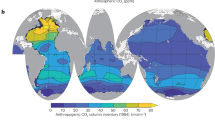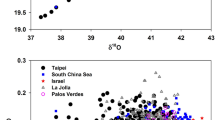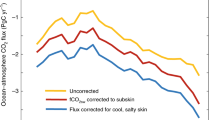Abstract
THE global budget for sources and sinks of anthropogenic CO2 has been found to be out of balance unless the oceanic sink is supplemented by an additional 'missing sink', plausibly associated with land biota1,25. A similar budgeting problem has been found for the Northern Hemisphere alone2,3, suggesting that northern land biota may be the sought-after sink, although this interpretation is not unique2–5; to distinguish oceanic and land carbon uptake, the budgets rely variously, and controversially, on ocean models2,6,7, 13CO2/12CO2 data2,4,5, sparse oceanic observations of (ref. 3) or 13C/12C ratios of dissolved inorganic carbon,4,5,8 or single-latitude trends in atmospheric O2 as detected from changes in O2/N2 ratio.9,10 Here we present an extensive O2/N2 data set which shows simultaneous trends in O2/N2 in both northern and southern hemispheres and allows the O2/N2 gradient between the two hemispheres to be quantified. The data are consistent with a budget in which, for the 1991–94 period, the global oceans and the northern land biota each removed the equivalent of approximately 30% of fossil-fuel CO2 emissions, while the tropical land biota as a whole were not a strong source or sink.
This is a preview of subscription content, access via your institution
Access options
Subscribe to this journal
Receive 51 print issues and online access
$199.00 per year
only $3.90 per issue
Buy this article
- Purchase on Springer Link
- Instant access to full article PDF
Prices may be subject to local taxes which are calculated during checkout
Similar content being viewed by others
References
Watson, R. T., Rodhe, H., Oeschger, H. & Siegenthaler, U. in Climate Change, The IPCC Scientific Assessment (eds Houghton, J.T., Jenkins, G. J. & Ephraums, J. J.) 1–40 (Cambridge Univ. Press, Cambridge, 1990).
Keeling, C. D., Piper, S. C. & Heimann, M. in Aspects of Climate Variability in the Pacific and Western Americas (ed. Peterson, D. H.) 305–363 (Geophys. Monogr. 55, American Geophysical Union, Washington DC, 1989).
Tans, P. P., Fung, I. Y. & Takahashi, T. Science 247, 1431–1438 (1990).
Ciais, P. et al. J. geophys. Res. 100, 5051–5070 (1995).
Ciais, P., Tans, P. P., Trolier, M., White, J. W. C. & Francey, R. J. Science 269, 1098–1102 (1995).
Keeling, C. D. et al. in Aspects of Climate Variability in the Pacific and Western Americas (ed. Peterson, D. H.) 165–236 (Geophys. Monogr. 55, American Geophysical Union, Washington DC, 1989).
Siegenthaler, U. & Sarmiento, J. L. Nature 365, 119–125 (1993).
Quay, P. D., Tilbrook, B. & Wong, C. S. Science 256, 74–79 (1992).
Keeling, R. F. & Shertz, S. R. Nature 358, 723–727 (1992).
Bender, M., Ellis, T., Tans, P. P. & Francey, R. J. and Lowe, D. Global biogeochem. Cycles 10, 9–21 (1996).
Conway, T. J. et al. J. geophys. Res. 99, 22831–22855 (1994).
Keeling, C. D., Whorf, T. P., Wahlen, M. & van der Plicht, J. Nature 375, 666–670 (1995).
Broecker, W. S. & Peng, T.-H. Nature 356, 587–589 (1992).
Keeling, R. F., Najjar, R. G., Bender, M. L. & Tans, P. P. Global biogeochem. Cycles 7, 37–67 (1993).
Keeling, R. F. & Peng, T.-H. Phil. Trans. R. Soc. Lond. B 348, 133–142 (1995).
Heimann, M. The Global Atmospheric Tracer Model TM2 (Tech. Rep. No. 10, Deutsches Klimarechenzentrum, Hamburg, 1995).
Brewer, P. G., Goyet, C. & Dyrssen, D. Science 246, 477–479 (1989).
Tarantola, A. and Valette, B. Rev. Geophys. Space. Phys. 20, 219–232 (1982).
Denning, A. S., Fung, I. Y. & Randall, D. A. Nature 243, 240–243 (1995).
Heimann, M. and Keeling, C. D. in Aspects of Climate Variability in the Pacific and Western Americas (ed. Peterson, D. H.) 237–275 (Geophys. Monogr. 55, American Geophysical Union, Washington DC, 1989).
Grace, J. et al. Science 270, 778–780 (1995).
Six, K. & Maier-Reimer, E. Global biogeochem. Cycles (submitted).
Keeling, R. F. & Severinghaus, J. P. in The Carbon Cycle (eds Wigley, T. M. & Schimel, D.) (Cambridge Univ. Press, in the press).
Francey, R. J. et al. Nature 373, 326–330 (1995).
Schimel, D. et al. in Climate Change 1994, Radiative Forcing of Climate Change and an Evaluation of the IPCC IS92 Emission Scenarios (eds Houghton, J. T. et al.) 35–71 (Cambridge Univ. Press, 1995).
Marland, G., Rotty, R. M. & Treat, N. L. Tellus 37B, 243–258 (1985).
Andres, R. J., Marland, G., Boden, T. & Bischoff, S. The Carbon Cycle (eds Wigley, T. M. & Schimel, D.) (Cambridge Univ. Press, in the press).
Hein, R., Crutzen, P. J. & Heimann, M. Global biogeochem. Cycles (in the press).
Sarmiento, J. L., Orr, J. C. & Siegenthaler, U. J. geophys. Res. 97, 3621–3645 (1992).
Watson, A. J., Nightingale, P. D. & Cooper, D. J. Phil. Trans. R. Soc. Lond. B 348, 125–132 (1995).
Sarmiento, J. L., Murnane, R. & Le Quéré, C. Phil. Trans. R. Soc. Lond. B 348, 211–219 (1995).
Keeling, R. F. thesis, Harvard Univ. (1988).
Severinghaus, J. P. thesis, Columbia Univ. (1995).
Keeling, R. F. J. atmos. Chem. 7, 153–176 (1988).
Author information
Authors and Affiliations
Rights and permissions
About this article
Cite this article
Keeling, R., Piper, S. & Heimann, M. Global and hemispheric CO2 sinks deduced from changes in atmospheric O2 concentration. Nature 381, 218–221 (1996). https://doi.org/10.1038/381218a0
Received:
Accepted:
Issue Date:
DOI: https://doi.org/10.1038/381218a0
This article is cited by
-
Variations in terrestrial oxygen sources under climate change
Science China Earth Sciences (2022)
-
Terrestrial carbon sinks in China and around the world and their contribution to carbon neutrality
Science China Life Sciences (2022)
-
Evaluation of the Potential Use of Satellite-Derived XCO2 in Detecting CO2 Enhancement in Megacities with Limited Ground Observations: A Case Study in Seoul Using Orbiting Carbon Observatory-2
Asia-Pacific Journal of Atmospheric Sciences (2021)
-
Carbon storage of the forest and its spatial pattern in Tibet, China
Journal of Mountain Science (2021)
-
Urban tree carbon density and CO2 equivalent of National Zoological Park, Delhi
Environmental Monitoring and Assessment (2021)
Comments
By submitting a comment you agree to abide by our Terms and Community Guidelines. If you find something abusive or that does not comply with our terms or guidelines please flag it as inappropriate.



